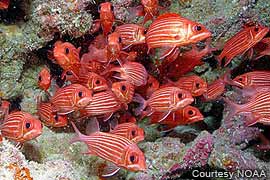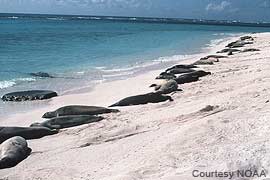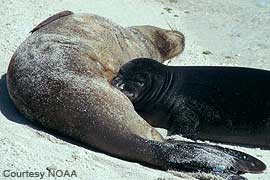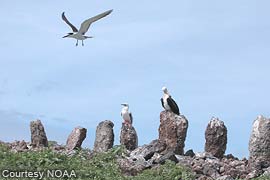Activists laud state and federal efforts to create the largest marine refuge in the world in the Northwestern Hawaiian Islands
Cha Smith, Executive Director of KAHEA: The Hawaiian-Environmental Alliance
On Friday, May 13, 2005 the Hawai‘i State Board of Land and Natural Resources voted unanimously to adopt a Refuge for state waters in the Northwestern Hawaiian Islands (NWHI), establishing protections that reflect the needs of this fragile and unique coral reef ecosystem. The rules would protect 100 percent of State waters from extractive uses, including commercial and recreational fishing, and require an entry permit for all other activities.
With this Refuge, the state places itself on the world stage by recognizing the importance of protecting what may be the last wild marine wilderness – the Northwestern Hawaiian Islands. The proposed Refuge is an example of a true Pu’uhonua, a place of safety that will help the endangered Hawaiian monk seals to recover and will provide the lobster population, decimated by years of over-fishing, an opportunity to hopefully survive.
“Most significant for the public benefit is that the proposed marine Refuge insures that potential replenishment of marine resources from this special area to the main Hawaiian Islands will continue,” said Isaac Harp, 'Ïlio'ulaokalani Coalition Board member and former commercial fisherman.
 |
|
 |
|
The proposed marine Refuge would help potential replenishment of marine resources at the main Hawaiian Islands and also help the endangered Hawaiian monk seals to recover.
|
Stephanie Fried, Senior Scientist of the conservation group Environmental Defense noted that, “The state's plan greatly adds protections to the NWHI ecosystem, is based on sound science and public input and provides an example of national and international leadership”
The Refuge represents the second attempt to regulate state waters of the Northwestern Hawaiian Islands. The Department of Land and Natural Resources’ (DLNR) first proposal, a fishery management area in the NWHI, was soundly rejected throughout Hawai’i by environmentalists and the Native Hawaiian community.
Peter Young, DLNR’s Director, acknowledged that public support was crucial to his decision. Hawai‘i residents have demonstrated unwavering support for strong protections for the Northwestern Hawaiian Islands and the issue has prompted more citizen participation than any other public trust issue in the state’s history. More than thirty separate hearings on the NWHI in the past five years generated over 100,000 letters, emails and faxes from the concerned public calling for the strongest possible protections for this unique and wondrous ecosystem. The state received more than 24,000 written and oral testimonies during the most recent (July 2004) round of hearings.
Federal Refuge Proposed for NWHI Coral Reef Ecosystem Reserve
|
 |
|
In need of a true Pu’uhonua, a place of safety, the endangered Hawaiian monk seal.
|
On Monday, May 16, 2005, the state’s Refuge was taken a step further when Representative Ed Case (Hawai‘i) eloquently introduced the NWHI National Marine Refuge Act in Congress. The Act builds on the state’s Refuge and incorporates the Hawaiian Island Refuge managed by the U.S. Fish and Wildlife Service, which protects the landmasses and surrounding shallow waters. The Refuge Act would also establish a separate office of Sanctuary and Refuge within the National Ocean Service, recognition long sought after by the Marine Sanctuary program.
The Northwestern Hawaiian Islands Marine Refuge Act is a true reflection of this complex ecosystem. It would meet the needs of the gravely endangered Hawaiian monk seal, the threatened and endangered sea turtles and the needs of the lobsters struggling to recover from over-fishing. This legislation builds on the legacy of protection that was begun by Teddy Roosevelt in 1909.
Summary points of the proposed federal NWHI Refuge/Pu’uhonua:
- Establishes conservation as "exclusive basis for all decisions by federal agencies"; utilizes a precautionary approach
- Prohibits commercial use, sale of refuge resources, any interference with enforcement and strictly limits all activities
- Provides buyout for existing nine commercial bottomfish fishers
- Establishes within the National Ocean Service an Office for Refuge management, with no requirement for fishery council involvement in Refuge rulemaking
- Mandates that all vessels over 25 ft be certified free of alien species by an inspector; carry VMS, federal observer and post $1 million vessel grounding bond.
Congressman Ed Case: “…shouldn't there be some special places in our marine world which are in fact true reserves – truly off-limits, where our marine species can live and thrive in their natural state, without the invasive, extractive hand of humankind? I know in my heart that the answer is yes, and that the Northwestern Hawaiian Islands and their waters are where we should just do it.”
Currently, there is a process to propose that federal waters of the Northwestern Hawaiian Islands be designated a National Marine Sanctuary and determine protection measures for this remote ecosystem. Federal waters surround the proposed State Refuge and the U.S. Fish and Wildlife Hawaiian National Refuge. The sanctuary designation process within the NOAA and the Department of Commerce, however, is marred by a lack of transparency and by ongoing attempts by federal officials to repeal and weaken existing protections established for the Northwestern Hawaiian Islands Coral Reef Ecosystem Reserve.
The National Refuge eliminates the political dance choreographed by NOAA as they develop management plans for a proposed sanctuary in the NWHI. So far, NOAA has proposed weakening existing protections established by Executive Order in 2000. As NOAA strives to meet the needs of all stakeholders instead of the resource, its proposals have included allowing commercial fishing and reducing protected habitat for the gravely endangered Hawaiian monk seal. The natural and cultural treasures of this irreplaceable marine ecosystem deserve better.
The NWHI Marine Refuge Act also eliminates NOAA’s problematic mandatory 5-year review of whatever protection measures are adopted by the sanctuary program, which would open protections up to political pressure every five years instead of ensuring that strong and lasting regulations safeguard the resource.
|
 |
|
Stones placed several hundred years ago by Polynesian visitors at Mokumanamana, or Necker Island, for spiritual or navigational purposes.
|
Vicky Holt Takamine, President, ‘Ïlio’ulaokalani Coalition explains: “the Northwestern Hawaiian Islands are viewed by Native Hawaiians as a truly special place and referred to as ‘Na Kupuna Islands,’ revered ancestors to the Main Islands. They hold great cultural and religious significance to the Hawaiian people. We have always maintained that the Northwestern Hawaiian Islands are a nursery to the lower Islands and that by providing strong protections for the Kupuna Islands, we will be protecting fish stocks here.”
The Northwestern Hawaiian Islands hui represents a broad network of fishers, Native Hawaiians, scientists, divers and Hawai’i residents associated with the `Ïlio’ulaokalani Coalition, KAHEA: The Hawaiian-Environmental Alliance, Environmental Defense and Sierra Club.
Na ‘Ilioholoikauaua (Hawaiian monk seals) call on your help to support the H.R. 2376, the National Refuge Act. Continued public support can create a true Pu’uhonua or place of refuge for the remote and fragile Northwestern Hawaiian Islands. Please visit KAHEA’s website to find out how.
Further information
Paul Koberstein. 2003. Plundering the Pacific: the cats who run the fishhouse. The Monachus Guardian 7 (1): December 2003.
Cha Smith. 2003. NWHI: Creating a Pu‘uhonua for Future Generations. The Monachus Guardian 6 (1): June 2003.
The following documents can be found at www.kahea.org:
DLNR’s Press Release
Hawai‘i Regulations Creating a Refuge for NWHI State waters
Congressman Case Floor Speech
National Marine Refuge Act
NWHI hui Press Releases
Marine Mammal Commission report in press
The Marine Mammal Commission’s Annual Report to Congress for 2004 was due for publication just as we went to press. For those interested in current Hawaiian monk seal population trends, human and natural threats to the species, the future of the Coral Reef Ecosystem Reserve, and efforts to encourage Monachus schauinslandi’s repopulation of the Main Hawaiian Islands, the MMC report is an indispensable guide.
Courtesy of the Commission, the relevant Hawaiian monk seal chapter will be made available for download in the Monk Seal Library in due course.
Hawaiian Press Watch
Case seeks U.S. protection for N.W. Islands. 17 May, 2005
U.S. Rep. Ed Case yesterday proposed establishing the Northwestern Hawaiian Islands as the largest marine refuge in the world, banning all fishing within 50 miles of shore.
The proposal, contained in legislation the Hawai’i Democrat introduced in Congress yesterday, took the environmental community by surprise, but those who had read the bill said they were strongly supportive.
“This builds on the legacy begun by Teddy Roosevelt in 1909, and it extends the extraordinary, historic momentum of the state’s action Friday,” said Stephanie Fried, senior scientist with Environmental Defense. “It seems to be a crystal-clear reflection of public input.”
Roosevelt established the 1,100 miles of islands beyond Kaua’i as a wildlife refuge. The state Board of Land and Natural Resources on Friday approved rules that would prohibit all fishing and require an entry permit for any other activities within three miles of shore in the Northwestern Hawaiian Islands.
Case said his proposal would mimic the state’s restrictions, but would carry them out to 50 miles from most of the islands, and a little farther from Kure Atoll, to encompass certain seamount habitats. (Jan TenBruggencate, Honolulu Advertiser)
http://the.honoluluadvertiser.com/article/2005/May/17/ln/ln18p.html
Case introduces bill to create world’s largest marine refuge in Northwestern Hawaiian Islands. Refuge would do for ocean preservation what Yellowstone Park did for land conservation. 16 May, 2005
Washington, D.C. - Congressman Ed Case (Hawaii, 2nd District) today introduced legislation that would create “the largest marine protected area in our world” – larger than Australia’s Great Barrier Reef Marine Protected Area – in the waters of the Northwestern Hawaiian Islands stretching across 1,200 miles of the Pacific Ocean from Nihoa Island to Kure Atoll.
“This initiative will provide the highest possible level of federal protection to an incredibly special area of U.S. waters that is home to 70 percent of our nation’s coral reefs and some 7,000 species-up to half of them endemic to the area and found nowhere else on earth. Protecting this area would create an ‘Ocean Yellowstone’ comparable to our Yellowstone National Park, whose establishment in 1872, although itself revolutionary for its time, became the foundation of our National Park System,” said Case, whose congressional district includes the Northwestern Hawaiian Islands.
Case said the highest protection of the entire area is necessary because of growing threats posed by invasive species, marine debris, fishing and other human occupancy and extractive uses. But beyond these basic threats, Case said that there “should be some special places in our marine world which are in fact true reserves: truly off-limits, where our marine species can live and thrive in their natural state, without the invasive, extractive hand of humankind. The Northwestern Hawaiian Islands is this place.”
The proposed Refuge is home to many species of coral, fish, birds, and marine mammals, including the highly endangered Hawaiian monk seal, threatened green sea turtle, and endangered leatherback, loggerhead and hawksbill sea turtles. An estimated 14 million seabirds thrive in the islands and their waters, including 99 percent of the world’s Laysan albatrosses and 98 percent of the black-footed albatross population. This also may be the last predator-dominated marine ecosystem left on earth, with about 55 percent of the total fish biomass made up of predator species.
“My proposal, the Northwestern Hawaiian Islands National Marine Refuge Act of 2005, would cover 137,000 square miles of our country’s reefs, banks, seamounts and oceans, eclipsing Australia’s Great Barrier Reef Marine Protected Area of 125,000 square miles,” Case added. “Virtually all activities in the Refuge, generally from land to fifty miles out to sea, would be by permit only. Permitted activities would include scientific research, but would prohibit commercial fishing and other extractive practices except in very narrow circumstances. Existing commercial fishing permit holders would be bought out at fair value.”
Case’s bill would assign management of the new Refuge, the first of its kind in our country, to a new Office of National Marine Sanctuaries and Refuges within the current managing entity, the U.S. Commerce Department’s National Ocean Service. The Office would manage the Refuge in cooperation with the State of Hawaii, and in consultation with an advisory council including representatives from the State of Hawaii and the Native Hawaiian, scientific and marine conservation communities.
“It is vital to note that this bill is grounded solidly in the cultural heritage and traditions of the indigenous peoples of Hawaii, our Native Hawaiians,” said Case, who specifically cited the work of Kahea: the Hawaiian Environmental Alliance, among other environmental and Native Hawaiian advocacy groups. The bill provides for the continued traditional use of the Refuge by Native Hawaiians for religious, cultural and sustenance purposes.
Case praised the action of Hawaii’s Board of Land and Natural Resources last Friday, May 13th, to establish the Northwestern Hawaiian Islands Marine Refuge in state waters, generally extending three miles out from land. “This bill would now complete the penumbra of protection for this incredible resource and truly discharge our responsibility of stewardship.”
Case’s prepared remarks for inclusion in the Congressional Record on introduction of the Northwestern Hawaiian Islands National Marine Refuge Act of 2005, as well as the text of the bill, may be found on the top of the splash page of Case’s congressional website at www.house.gov/case. (News from Congressman Ed Case)
http://wwwc.house.gov/case/
Setting refuge status for northwestern isles a wise move. May 12, 2005
The state steps to the forefront in protecting the 1,200-mile stretch of the Northwestern Hawaiian Islands under a bold proposal to establish a refuge by its own authority. The Board of Land and Natural Resources should adopt the plan, which makes clear to the federal government the importance the people of Hawaii place on the archipelago and the health of the ocean.
The northwestern islands, declared a marine reserve by President Clinton in 2000, is being considered for re-designation as a national “sanctuary,” putting partial direction under the U.S. Department of Commerce. However, sanctuary status, which would regulate a 50-mile zone around the islands, might still allow fishing and other “extractive” practices, contrary to public wishes.
The state’s jurisdiction extends only three miles out, but its proposal would bar commercial and recreational fishing, removal of natural resources and visits for purposes other than permitted research, management or Hawaiian cultural activities.
It would preserve a resource vital to sustaining the reef ecosystem that serves as an ocean “nursery” for fish and other sea life and a haven for federally protected species. (Editorial, Honolulu Star Bulletin)
http://starbulletin.com/2005/05/12/editorial/editorials.html
Marine refuge helps fishing industry, too. 7 May, 2005
The state Department of Land and Natural Resources has sensibly stepped up to fulfill one of its important roles – that of conservator – by proposing the creation of a marine refuge around the Northwestern Hawaiian Islands.
Under the state plan, all fishing would be prohibited in waters three miles around each island and atoll in the archipelago that extends 1,200 miles, between Nihoa and Kure. The refuge is envisioned as a way to protect the coral reefs that are home to native plants and, most importantly, the fertile breeding area for many marine animals, including the endangered monk seal and green sea turtle...
Above all, it’s in the long-term interest of the fisheries themselves that the fleet of islands serving as nurseries to many fish species be protected. Too few examples of pristine ocean wilderness remain to let this precious ecosystem degrade. (Editorial, Honolulu Advertiser)
http://the.honoluluadvertiser.com/article/2005/May/07/op/op01p.html
Northwestern Islands get protection plan. 6 May, 2005
State waters surrounding the Northwestern Hawaiian Islands would become a highly protected “marine refuge” under a proposal announced yesterday.
Peter Young, director of the state Department of Land and Natural Resources, visited the remote islands last year and was astonished to see a school of large ulua visible from shore, thousands of birds on a plane runway, and monk seals and sea turtles lounging on beaches.
“We are dealing with a special place, and it’s different,” Young said yesterday in announcing that he wants to give the Northwestern Hawaiian Islands the highest level of protection.
That would mean no commercial or recreational fishing or removal of any natural or cultural resources from state-controlled waters, according to draft rules to be considered by the Board of Land and Natural Resources at its meeting next Friday. Visits to the refuge would only be allowed for research, management and native Hawaiian cultural purposes that do not harm the environment – and only then with a state permit. (Diana Leone, Honolulu Star Bulletin)
http://starbulletin.com/2005/05/06/
Derelict fishing gear mapped in bid to clean up. 29 April, 2005
Researchers using satellites and aircraft have located a concentration of lost or abandoned fishing nets that drift through the oceans posing a danger to fish and other wildlife, the National Oceanic and Atmospheric Administration said Friday. (MSNBC News)
http://msnbc.msn.com/id/7680202/
U.S. Endangered Species Act Works, Study Finds. 18 April, 2005
The longer an animal or plant species is protected under the U.S. Endangered Species Act, the more likely it is to recover, a new study says. The finding contradicts recent criticism that the act has returned too few species to full health. (Maryann Mott, National Geographic News)
http://news.nationalgeographic.com/news/2005/04/0418_050418_endangered.html
Drivers harm natural areas. The illegal use of popular all-terrain vehicles takes an environmental toll that alarms the state. March 7, 2005
For years, off-roading enthusiasts have flocked to secluded open spaces and beaches around Oahu, especially near Mokuleia, to test out their four-wheel-drive vehicles or race with friends. Souped-up pickups or sport utility vehicles, with extra-large tires and special suspensions, have been popular in the islands since the early 1990s...
Beaches from Makua Beach on the Leeward Coast to Army Beach in Mokuleia are also seeing heavy traffic, with four-wheelers threatening ancient Hawaiian burial sites, shoreline animals, like the endangered Hawaiian monk seal, and even beachgoers. (Mary Vorsino, Honolulu Star Bulletin)
http://starbulletin.com/2005/03/07/news/story1.html
Gathering Place. February 17, 2005
On a recent visit to Midway I was sad to see dozens of white terns, the manu-o-ku that Polynesian voyagers used to guide them to land, dead on the ground.
Scientists there explained that they died of starvation. White terns live off the small fish that swim up to the surface of the sea because of large fish below them. But with our large fish being taken by longline fishermen, the little fish don’t rise to the surface as much and the white terns starve.
The endangered Hawaiian monk seal’s diet includes lobster, and many scientists believe that this species is starving because a main food source has been depleted because of overfishing. The lobster has a long life cycle; it takes many years for an egg to mature into an adult with the ability to reproduce. In the 1980s and ‘90s, in the height of the take, lobster fishermen didn’t bother to save the young or egg-bearing females, thereby causing the lobster population to crash, which eventually led to the current ban. (Laura L. Thompson, Honolulu Star Bulletin)
http://starbulletin.com/2005/02/17/editorial/commentary.html
It takes a village to raise a Monk Seal. February 2 – February 15, 2005
There’s a new, very local-style visitor who seems to be taking up residence here on Maui’s shoreline along the Kuau/Ho’okipa area. Have you seen her?
She’s a baby monk seal, wearing numbered red tags on her flippers (left #I25, right #I26). She was born August 13, 2004, on the Moloka’i at Kalaupapa. She’s doing well, as she bravely made her way to Maui within her first few months of life and was first logged in with the Maui Watch Team on January 6, 2005 at Ho’okipa.
If we’re lucky and take good care, she’ll thrive and swim on to enrich the critically endangered population of Hawaiian monk seals and grace us with pups of her own. She is, indeed, a link in the chain of hand-to-hand hope for the future of these precious islands. The Maui Watch Team needs volunteers now more than ever. (Michele Morris, Maui Monk Seal Watch Team, Haleakala Times)
http://mauisfreepress.com/archives/archives2005/features/02_02_05/feature5.html
Seal steals the show on busy Waikiki Beach. January 22, 2005
An endangered Hawaiian monk seal clambered onto usually busy Waikiki Beach yesterday to the delight of tourists and local residents.
“It’s very, very rare to see them in Waikiki,” said Thea Johanos, National Oceanic and Atmospheric Administration wildlife biologist, though they have come a few times in the past.
“We have seals on the North Shore (of Oahu), Waianae and Sandy Beach, but I haven’t heard of a seal at Waikiki,” said Jeff Walters, biologist for the state Division of Aquatic Resources.
Volunteers for NOAA have tracked this adult male seal, dubbed “Chester” because of a recognizable scar on his chest. He usually inhabits the southeastern waters of Oahu, Johanos said.
The monk seal, one of about 1,300 in the world, crawled at 9:30 a.m. onto the beach behind the Colony Surf Hotel. Police and Department of Land and Natural Resources officials were immediately called and surrounded the animal with yellow tape and posted signs to keep a distance of 150 feet. (Leila Fujimori, Honolulu Star Bulletin)
http://starbulletin.com/2005/01/22/news/story3.html
EndQuote
World’s largest MPA proposed for Hawaii
“My proposal, the Northwestern Hawaiian Islands National Marine Refuge Act of 2005, would cover 137,000 square miles of our country’s reefs, banks, seamounts and oceans, eclipsing Australia’s Great Barrier Reef Marine Protected Area of 125,000 square miles,” Case added. “Virtually all activities in the Refuge, generally from land to fifty miles out to sea, would be by permit only. Permitted activities would include scientific research, but would prohibit commercial fishing and other extractive practices except in very narrow circumstances. Existing commercial fishing permit holders would be bought out at fair value.”
Source: Case introduces bill to create world’s largest marine refuge in Northwestern Hawaiian Islands. News from Congressman Ed Case/Monday, May 16, 2005.
|
|



